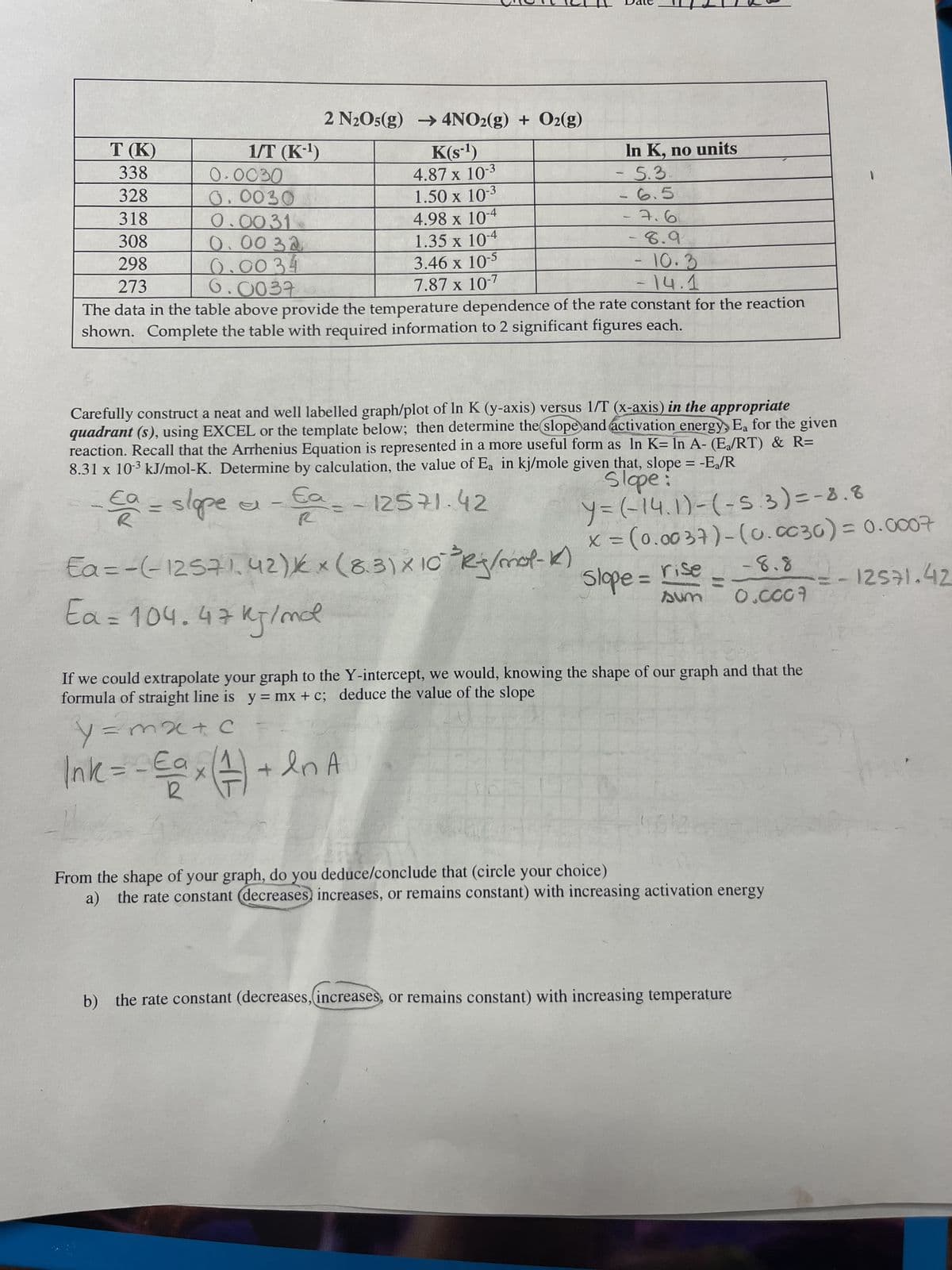From the shape of your graph, do you deduce/conclude that (circle your chole a) the rate constant (decreases increases, or remains constant) with increasing activation energy b) the rate constant (decreases, (increases, or remains constant) with increasing temperature
From the shape of your graph, do you deduce/conclude that (circle your chole a) the rate constant (decreases increases, or remains constant) with increasing activation energy b) the rate constant (decreases, (increases, or remains constant) with increasing temperature
Chemistry
10th Edition
ISBN:9781305957404
Author:Steven S. Zumdahl, Susan A. Zumdahl, Donald J. DeCoste
Publisher:Steven S. Zumdahl, Susan A. Zumdahl, Donald J. DeCoste
Chapter11: Properties Of Solutions
Section: Chapter Questions
Problem 95E
Related questions
Question
100%

Transcribed Image Text:1/T (K-¹)
2 N₂O5(g) → 4NO2(g) + O₂(g)
K(S-¹)
4.87 x 10-3
1.50 x 10-³
4.98 x 10-4
1.35 x 10-4
3.46 x 10-5
7.87 x 10-7
T (K)
338
0.0030
328
0.0030
318
0.0031
308
0.0032
298
0.0034
273
6.0037
The data in the table above provide the temperature dependence of the rate constant for the reaction
shown. Complete the table with required information to 2 significant figures each.
- a=-12571.42
In K, no units
5.3
- 6.5
7.6
8.9
Carefully construct a neat and well labelled graph/plot of In K (y-axis) versus 1/T (x-axis) in the appropriate
quadrant (s), using EXCEL or the template below; then determine the slope and activation energy, Ea for the given
reaction. Recall that the Arrhenius Equation is represented in a more useful form as In K= In A- (Ea/RT) & R=
8.31 x 10-³ kJ/mol-K. Determine by calculation, the value of Ea in kj/mole given that, slope = -E/R
slope:
- Ca = slope & - Ga=
€ag
Ea=-(-12571.42) x (8.3) x 10 Rg/mol-K)
Ea=104.47 kj/md
10.3
- 14.1
Y = (-14.1)-(-5.3) = -8.8
x = (0.0037) - (0.0030) = 0.0007
-8.8
0.0009
Slope = rise
=-12571.42
sum
If we could extrapolate your graph to the Y-intercept, we would, knowing the shape of our graph and that the
formula of straight line is y = mx + c; deduce the value of the slope
y=mx+c
Ink = - € ax ( ² ) + &n A
1718
16106
From the shape of your graph, do you deduce/conclude that (circle your choice)
a) the rate constant (decreases increases, or remains constant) with increasing activation energy
b) the rate constant (decreases, (increases, or remains constant) with increasing temperature
Expert Solution
This question has been solved!
Explore an expertly crafted, step-by-step solution for a thorough understanding of key concepts.
This is a popular solution!
Trending now
This is a popular solution!
Step by step
Solved in 4 steps with 1 images

Knowledge Booster
Learn more about
Need a deep-dive on the concept behind this application? Look no further. Learn more about this topic, chemistry and related others by exploring similar questions and additional content below.Recommended textbooks for you

Chemistry
Chemistry
ISBN:
9781305957404
Author:
Steven S. Zumdahl, Susan A. Zumdahl, Donald J. DeCoste
Publisher:
Cengage Learning


Chemistry: An Atoms First Approach
Chemistry
ISBN:
9781305079243
Author:
Steven S. Zumdahl, Susan A. Zumdahl
Publisher:
Cengage Learning

Chemistry
Chemistry
ISBN:
9781305957404
Author:
Steven S. Zumdahl, Susan A. Zumdahl, Donald J. DeCoste
Publisher:
Cengage Learning


Chemistry: An Atoms First Approach
Chemistry
ISBN:
9781305079243
Author:
Steven S. Zumdahl, Susan A. Zumdahl
Publisher:
Cengage Learning

General, Organic, and Biological Chemistry
Chemistry
ISBN:
9781285853918
Author:
H. Stephen Stoker
Publisher:
Cengage Learning

Chemistry: The Molecular Science
Chemistry
ISBN:
9781285199047
Author:
John W. Moore, Conrad L. Stanitski
Publisher:
Cengage Learning

Principles of Modern Chemistry
Chemistry
ISBN:
9781305079113
Author:
David W. Oxtoby, H. Pat Gillis, Laurie J. Butler
Publisher:
Cengage Learning